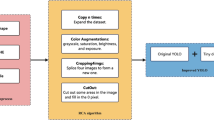Abstract
The conventional isosurface techniques are not competent for meshing a heterogeneous object because they assume that the object is homogeneous. Thus the visualization method taking the heterogeneity into account is desired. In this paper, we propose a novel algorithm to extract the boundary surfaces from a heterogeneous object in one pass, whose remarkable advantage is free of the number of materials contained. The heterogeneous object is first classified into a series of homogeneous material components. Then each component is enclosed with a 2D-manifold boundary surface extracted via our algorithm. The information important to the heterogeneous object is also provided, such as the interface between two materials, the intersection curve where three materials meet and the intersection point where four materials meet. To improve the performance, the algorithm is also designed and implemented on GPU. Experimental results demonstrate the effectiveness and efficiency of the proposed algorithm.
Similar content being viewed by others
References
Wang C C L. Direct extraction of surface meshes from implicitly represented heterogeneous volumes. Computer-Aided Design, 2007, 39(1): 35–50.
Lorensen W E, Cline H E. Marching cubes: A high resolution 3D surface construction algorithm. Computer Graphics, 1987, 21(4): 163–169.
Moller T. A fast triangle-triangle intersection test. Journal of Graphics Tools, 1997, 2(2): 25–30.
Nielson G M. On marching cubes. IEEE Transactions on Visualization and Computer Graphics, 2003, 9(3): 283–297.
Rosenthal P, Linsen L. Direct isosurface extraction from scattered volume data. In Proc. Eurograhpics/IEEE-VGTC Symposium on Visualization, May 2006, pp.99–106.
Nielson G, Franke R. Computing the separating surface for segmented data. In Proc. the 8th Conference on Visualization, Oct. 1997, pp.229–233.
Bonnell K S, Joy K I, Hamann B, Schikore D R, Duchaineau M. Constructing material interfaces from data sets with volume-fraction information. In Proc. the Conference on Visualization 2000, Oct. 2000, pp.367–372.
Wu Z, Sullivan J M. Multiple material marching cubes algorithm. International Journal for Numerical Methods in Engineering, 2003, 58(2): 189–207.
Wang C C L. Computing on rays: A parallel approach for surface mesh modeling from multi-material volumetric data. Computers in Industry, 2011, 62(7): 660–671.
Ju T, Losasso F, Schaefer S, Warren J. Dual contouring of hermite data. In ACM Trans. Graph., 2002, 21(3): 339–346.
Feng P, Jn T, Warren J. Piecewise tri-linear contouring for multi-material volumes. In Proc. the 6th International Conference on Advances in Geometric Modeling and Processing, June 2010, pp.43–56.
Patil L, Dutta D, Bhatt A D et al. Representation of heterogeneous objects in ISO 10303 (STEP). In Proc. the ASME International Mechanical Engineering Congress and Exposition, Nov. 2000, pp.355–363.
Jackson T R, Cho W, Partikalakis N M et al. Memory analysis of solid model representations for heterogeneous objects. Journal of Computing and Information Science in Engineering, 2002, 2(1): 1–10.
Pratt M J, Bhatt A D, Lyons K W et al. Progress towards an international standard for data transfer in rapid prototyping and layered manufacturing. Computer-Aided Design, December 2002, 34(14): 1111–1121.
Shammaa M H, Suzuki H, Ohtake Y. Extraction of isosurfaces from multi-material CT volumetric data of mechanical parts. In Proc. the 2008 ACM Symposium on Solid and Physical Modeling, June 2008, pp.213–220.
Pascucci V. Isosurface computation made simple: Hardware acceleration, adaptive refinement and tetrahedral stripping. In Proc. IEEE TVCG Symposium on Visualization, May 2004, pp.293–300.
Klein T, Stegmaier S, Ertl T. Hardware-accelerated reconstruction of polygonal isosurface representations on unstructured grids. In Proc. the 12th Pacific Conference on the Computer Graphics and Applications, Oct. 2004, pp.186–195.
Kipfer P, Westermann R. GPU construction and transparent rendering of iso-surfaces. In Proc. the Modeling and Visualization, 2005, pp.241–248.
Buatois L, Caumon G, Lévy B. GPU accelerated isosurface extraction on tetrahedral grids. In Proc. the 2nd International Conference on Advances in Visual Computing, Part I, Nov. 2006, pp.383–392.
NVIDIA Corporation. NVIDIA CUDA C Programming Guide: Version 3.2. NVIDIA Corporation, 2010.
Dias S, Bora K, Gomes A. CUDA-based triangulations of convolution molecular surfaces. In Proc. the 19th ACM International Symposium on High Performance Distributed Computing, June 2001, pp.531–540.
Hung C M, Buning P G. Simulation of blunt-fin-induced shock-wave and turbulent boundary-layer separation. Journal of Fluid Mechanics, 1984, 154: 163–185.
MacLeod R S, Johnson C R, Ershler P R. Construction of an inhomegeneous model of the human torso for use in computational electrocardiography. In Proc. the 13th Annual International Conference of IEEE Engineering in Medicine and Biology Society, Oct. 31-Nov. 3, 1991, pp.688–689.
Scientific Computing and Imaging Institute (SCI) of Utah University. SCIRun: A scientific computing problem solving environment. http://www.scirun.org.
Author information
Authors and Affiliations
Corresponding author
Additional information
This work is supported by the National Natural Science Foundation of China under Grant Nos. 60933007 and 61170138, the National Basic Research 973 Program of China under Grant No. 2009CB320801, the Program for New Century Excellent Talents in University of Ministry of Education of China under Grant No. NCET-10-0728.
Rights and permissions
About this article
Cite this article
Wang, M., Feng, JQ. 2D-Manifold Boundary Surfaces Extraction from Heterogeneous Object on GPU. J. Comput. Sci. Technol. 27, 862–871 (2012). https://doi.org/10.1007/s11390-012-1270-8
Received:
Revised:
Published:
Issue Date:
DOI: https://doi.org/10.1007/s11390-012-1270-8




